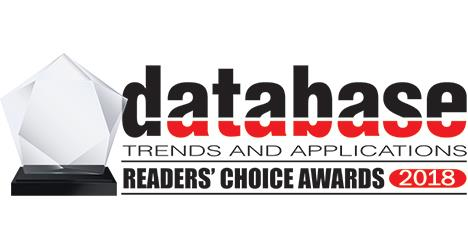The votes have been counted and the results are in. Now, it’s time to offer congratulations as Database Trends and Applications magazine unveils the 2018 Readers’ Choice Awards winners.
Data has been called many things, including the new electricity and the new oil, for its transformative powers to illuminate opportunities and fuel growth. But, at Data Summit 2018, Paul Sonderegger, senior data strategist, Oracle, noted in a keynote that data is actually a new form of capital, on a par with financial and human capital for creating new products and services. In economics, he explained, capital is an asset produced through a process and is then a necessary input to some other good or service. “Data fulfills this definition.”
Exploiting this capital, and increasing its value, is the goal of many organizations. But, in order to do so, they must have the right tools.
To help add perspective and acknowledge the products and services that have been deemed by our readers to provide unique value, DBTA created the Readers’ Choice Awards. Unlike any other awards programs conducted by DBTA, this one is special because the nominees are submitted and the winners are chosen by the experts—whose opinions carry more weight than all others—you, the readers.
With 28 categories, including a new one—best artificial intelligence solution—this year, there was plenty of opportunity to give credit where it is due. Many of the vendors and products are well-known with market-leading positions established over many years. However, there are also newer names in the mix, representing the rapidly evolving nature of information technology solutions and services.
MultiValue database technology continues to boost a strong following of loyal supporters. This NoSQL database technology is found in many industry verticals, including retail, travel industry, oil & gas, healthcare, government, banking, and education.
Highly customized, mission-critical applications have been built on MultiValue database technology, which is sometimes called the fifth NoSQL database technology. The MultiValue database dates back to the mid-1960s, with Don Nelson and Dick Pick widely credited as the founding fathers of the technology. Also referred to as Pick or MultiDimensional, a key advantage of MultiValue, is the database structure’s use of attributes that can have multiple values, rather than one single value as with relational technology.
MultiValue software vendors continue to address emerging challenges and opportunities that are affecting the IT landscape by adding features such as support for 64-bit computing, RESTful services, and new languages, enhanced replication for HA/DR, cloud enablement, mobile access, and integration with other enterprise systems, including relational and other NoSQL database management systems.
According to a new Unisphere Research survey sponsored by Quest Software that looks at the changing role of the DBA in light of new challenges in database administration, although the emergence of a wide variety of new and significant data types that have been brought under management during the last decade has captured a lot of attention, managing structured data continues to be central to most organizations.
Companies are managing massive amounts of data and support an impressive number of database instances. As Figure 1 shows, nearly 60% of the respondents have more than 100TB of structured data under management. And, that data is spread over a lot of database instances. More than 40% of the respondents have more than 100 database instances running. Close to 20% have more than 500 database instances in operation.
To manage this data, companies use an array of database systems. Oracle and Microsoft SQL Server continue to be the overwhelming market leaders in relational database management systems (RDBMSs). But respondents also mentioned using more than 20 relational, NoSQL, or MultiValue DBMSs in their operations.
MultiValue users are facing growing challenges in the areas of security, big data, and BYOD (Bring Your Own Device) when providing vertical applications to their end user base.
The latest updates from vendors seek to address these growing concerns while also staying ahead of the curve.
“Technology changes. Customer expectations grow. Developers need a product that lets them leverage their experience and skills. We believe that we’ve made OpenInsight 10 that product,” said Mike Ruane, President and CEO of Revelation Software.


